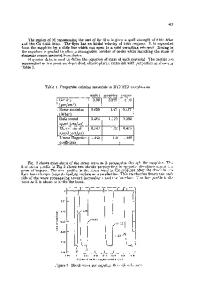Bond Strength of Pressed Composites
- PDF / 437,057 Bytes
- 6 Pages / 414.72 x 648 pts Page_size
- 26 Downloads / 417 Views
STRENGTH OF
Donald A.Wiegand, ARDEC,
PRESSED COMPOSITES
Picatinny Aresnal, NJ 07806-5000
ABSTRACT Composites samples containing 80% and 85% organic filler in a polymer-plastizer binder were produced by mixing, extruding, cutting, drying and pressing. Before pressing the extruded material was in some cases coated with a thin layer of graphite (= one micron) for ease in pressing. As part of a general study of these composites the compressive strength, 0 m, was determined as a function of temperature, strain rate and the thickness of the graphite coating. Without graphite am increases with decreasing temperature and increasing strain rate. With graphite am has the same behavior above approximately -10 C, but is independent of both temperature and strain rate below -10 C for a strain rate of 1.0/Sec. In addition, the low temperature value of Om decreases with increasing graphite thickness. The cracking and fracture patterns are temperature and strain rate dependent and are different with and without graphite. These results indicate that the bond produced by pressing the graphite containing material is stronger than the composite above -10 C and weaker below -10 C so that failure initiates in the composite above -10 C and in the bond below -10 C. With decreasing strain rate this transition temperature decreases. The bonding is discussed. INTRODUCTION As part of a general study of the mechanical properties of pressed composites, the strength of two very similar pressed composites was investigated as a function of several parameters. The strength is of interest over the temperature range -45' to 650 C and over a strain rate range from less than 0.001 to greater than 10/sec. However, the strength is of particular interest at the lower end of this temperature range because of a problem with cracking on thermally cycling. To facilitate ease in pressing and in particular to alleviate a sticking problem a thin graphite coating was added to the composites before pressing. This graphite eliminated the sticking problem but may have aggravated the low temperature cracking problem. In order to gain some understanding of the differences in the types of bonding which are produced during the pressing process in samples with and without graphite, the strength was investigated over the above temperate and strain rate range and as a function of graphite coating thickness. EXPERIMENTAL The two composites have slightly different compositions. percentage of solids was either 80% or 85%, the percentage of 387 Mat. Res. Soc. Symp. Proc. Vol. 318. ©1994 Materials Research Society
The
polymer was 8% or 6% and the percentage of plastizer was 12% or 9%. The solid is an organic polycrystalline material with an average particle size of 4 microns. Both composites were prepared at two locations. Samples were prepared by mixing with a suitable solvent and extruding in cylinderical form at diameters of 0.127 or 0.254 cm. (0.05 or 0.1 in.). The material was then cut into cylinders with the length equal to the diameter and was dried to eliminate t
Data Loading...











